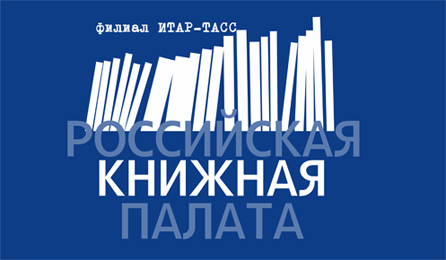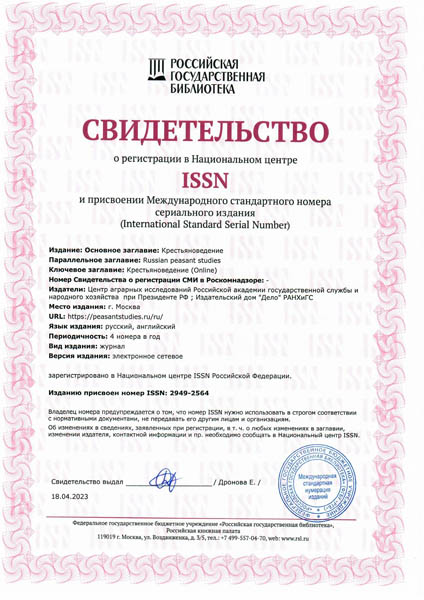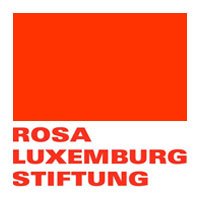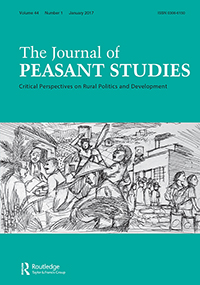Nikulin A.M., Trotsuk I.V. Utopias of Alexander Bogdanov and Alexander Chayanov: The choice of rural-urban development and its consequences for rural human capital and social differentiation // The Russian Peasant Studies. 2023. V.8. №4. P. 23-40.
DOI: 10.22394/2500-1809-2023-8-4-23-40
Annotation
A science-based conversation about the current state of rural areas, prospects for rural human capital and trends in rural differentiation is impossible without the conceptual approaches and futuristic projects of great Russian agrarian scientists. The article presents an attempt of comparing such ideas of two outstanding social thinkers of the early 20th century — Alexander Bogdanov and Alexander Chayanov, focusing on their utopias as representing the essential features (proletarian and peasant) of their social-economic and cultural-ethical views. Bogdanov and Chayanov had extensive encyclopedic knowledge and brilliant organizational skills; they wrote original works on social philosophy and political economy; both were prominent leaders of alternative social-political directions of the Russian Revolution. Moreover, Bogdanov and Chayanov wrote several famous utopias: Bogdanov’s utopia develops Marxist ideas of proletarian revolution and construction of socialism not only on earth but also in space; Chayanov’s utopia of moderate cooperative socialism defends the new revolutionary significance of the peasantry. The proletarian ideologist Bogdanov was skeptical about the political potential of the peasantry, arguing that opponents of proletarian revolution would use peasant conservatism against socialist revolution. The peasant ideologist Chayanov was skeptical about the creative potential of the working class, predicting that in the coming social revolution it would be used to build authoritarian-bureaucratic socialism. However, both thinkers sought prospects for rural-urban development through the analysis of possible ways of interaction between man and nature. Despite the ignorance of the positive revolutionary potential of the proletariat (Chayanov) and the peasantry (Bogdanov), both thinkers made huge contributions to the theory and practice of the Russian Revolution, and their utopian ideas still inspire the search for a new just, humane and happy world.
Keywords
A.V. Chayanov, A.A. Bogdanov, utopia, proletariat, peasantry, Marxism, corporatism, colonialism, human capital.
About the authors
Nikulin Alexander M., PhD (Economics), Head of the Center for Agrarian Studies, Russian Presidential Academy of National Economy and Public Administration; ViceRector for Research, Moscow School of Social and Economic Sciences. Vernadskogo Prosp., 82, Moscow, 119571.
E-mail: This email address is being protected from spambots. You need JavaScript enabled to view it.
Trotsuk Irina V., DSc (Sociology), Professor, Sociology Department, RUDN University; Senior Researcher, Center for Agrarian Studies, Russian Presidential Academy of National Economy and Public Administration; Intercenter, Moscow School of Social and Economic Sciences. 119571, Moscow, Vernadskogo Prosp., 82.
E-mail: This email address is being protected from spambots. You need JavaScript enabled to view it.
Bezgin V.B. Peasant children and adolescents in the agrarian protests of 1905–1907 // The Russian Peasant Studies. 2023. V.8. №3. P. 63-77.
DOI: 10.22394/2500-1809-2023-8-3-63-77
Annotation
The article considers the participation of village children and adolescents in the agrarian movement of 1905– 1907 as a part of the study of the role of the “generation of revolutionary change” in the peasant revolution of 1902–1922. The study aims at the historical justification of Danilov-Shanin’s concept through generational history combined with peasant studies and interdisciplinary approach. The author focuses on the underage peasants’ participation in the agrarian turmoil of 1905–1907, based on the archival documents and media materials. Police and governor’s reports and court records show that children and adolescents participated in such forms of peasant protest as destruction and arson of landlords’ fields and estates, which is evidenced by deaths and injuries of rural children during punitive actions and by illegal actions of rural adolescents mentioned in investigative cases, court proceedings and newspaper articles. Thus, rural children were observers of protests, while rural adolescents played an active role, sometimes including the role of rioters. Such a participation of children and adolescents in the peasant movement was determined by the nature of collective actions in the peasant community and by the peasant traditional attitude to ‘alien’ property. The experience of peasant protest was used by the younger rural generation during the ‘black redistribution’ of 1917.
Keywords
“Generation of revolutionary change”, rural community, peasantry, children, adolescents, protest.
About the author
Bezgin Vladimir B., DSc (History), Leading Researcher, Tambov State Technical University. Sovetskaya St., 106/5, Tambov, 392000.
E-mail: This email address is being protected from spambots. You need JavaScript enabled to view it.
Рub as a public space of the peasant world under the excise trade in Russia (1860s — 1890s)
Aug 18 2023Gorskaya N.I. Рub as a public space of the peasant world under the excise trade in Russia (1860s – 1890s) // The Russian Peasant Studies. 2023. V.8. №2. P. 21-35.
DOI: 10.22394/2500-1809-2023-8-2-21-35
Annotation
The article considers Russian rural pubs in the second half of the 19th century as a specific place of peasant meetings with the club features. The author describes rural life based on the narrative and legislative sources of the 1860s –1890s for the north-western and central agrarian provinces. By the end of the 19th century, the number of voluntary associations in Russia had significantly increased, and clubs were very popular. Until recently, clubs were considered as an exclusively social-cultural phenomenon of urban social and everyday life. In the late 19th century, the social functions of clubs widened beyond some leisure places for urban residents. In the second half of the 19th century, there was a tendency to consider pubs in rural areas not only as clubs but also as the sprouts of civil society. The article shows that pubs as a public space of peasant life had signs of urban clubs, but their functions were limited to leisure with some elements of business and communication. The traditional dichotomy of peasant life — family and community — gained additional meanings due to the expansion of peasant interaction and to the additional functionality of rural pubs. Moreover, as a phenomenon of rural life pubs represented a social anomaly (drunkenness) and absorbed some changes in the traditional way of peasant life, which reflected both the developing ties between the village and the city and the greater openness of the peasant world.
Keywords
Russia, the second half of the 19th century, peasantry, public space, excise duty, pub, club, leisure, everyday life.
About the author
Gorskaya Natalia I., DSc (History), Professor, Department of Russian History, Faculty of History and Law, Smolensk State University. Przhevalskogo St., 4, Smolensk, 214000.
E-mail: This email address is being protected from spambots. You need JavaScript enabled to view it.
Organization of agricultural production at the local level (Article of A.V. Chayanov in English)
Nov 25 2022Chayanov A. V. Organization of agricultural production at the local level (Article of A.V. Chayanov in English) // The Russian Peasant Studies. 2022. V.7. №3. P. 21-34.
DOI: 10.22394/2500-1809-2022-7-3-21-34
Annotation
This typescript was found in the fund of the Soviet party economist Lev Natanovich Kritzman (F. 528) in the Archive of the Russian Academy of Sciences (ARAS), and has never been published before. The typescript consists of 16 sheets without an autograph or any handwritten corrections and marks. The typescript does not have any direct indications of the time of its creation. There are two more documents: a letter to Kritsman of December 26, 1929, and a fragment of the text written by Chayanov’s hand, which is very close to this typescript and seems to be one of its drafts. On the back of this sheet, there is an inscription — “2nd House of Soviets. Room 327. To L. N. Kritzman from A. Chayanov”.
The typescript presents the concept of the gradual ‘rooting’ of the peasant economy in socialism through the voluntary ‘cooperative collectivization’ and with the incentive mechanisms of a purely economic nature. We can see similar theoretical bases in Lenin’s ‘cooperative plan’ and Bukharin’s theory of the peaceful ingrowth of capitalist elements into socialism. In these ideological-theoretical alternatives to Stalin’s collectivization, the peasant was considered a full-fledged subject of the economic activity and socialist construction, who needed all possible assistance with the state policy measures rather than commands.
Chayanov refused to choose between the state-farm construction and the total socialization of the peasant agricultural sector. He developed an alternative program of socialist construction, which included the thorough revision of his own positions on some issues. Based on the data, Chayanov sought to show how far the Soviet village had moved from the pinnacle of the pre-war economic development, and that the Soviet peasantry had ceased to be ‘an object of the agronomic influence’. Thus, according to Chayanov, in contemporary realities, old methods and schemes of agronomic work became ineffective.
Archivists dated the documents in the file to 1930. We do not know reasons for such dating, but it raises some doubts. We can be certain about relative dating and the lower chronological frame — 1927. According to the address-reference book All Moscow, Kritzman moved to Room 327 of the 2nd House of Soviets in 1927 (All Moscow (1927) Address-Reference Book for 1927: 3rd year of publication by the Moscow Council; with the new plan for the city of Moscow, Moscow, p. 147).
There are more doubts about the upper chronological frame. If all these documents are really related to each other, the text should be dated according to the letter to Kritzman. Chayanov wrote that he had not finished an agronomic essay (in collaboration with P. Ya. Gurov and S.G. Uzhansky), because he was terribly upset by the first days of work of the First All-Union Conference of Marxist Agrarians. Moreover, Chayanov “did not get Sadyrin’s article, which made him throw away the whole ‘reality’ and end his ‘cooperation’ in the same purely theoretical terms as he had started” (ARAS. F. 528. Inv. 5. F. 137. L. 1). Chayanov could mean his articles for the Great Soviet Encyclopedia, in which Kritzman edited the section of economic sciences and the subsection of economic policy until 1931; or for one of the periodicals, in which Kritzman was a member of the editorial board (for instance, On the Agrarian Front). Chayanov could use the word ‘cooperation’ as a title for the typescript sent to Kritzman for proofreading and editing.
By the end of 1929, Chayanov was in an extremely difficult situation, and it became even worse after the First All-Union Conference of Marxist Agrarians, at which Chayanov and his colleagues were ideologically persecuted. Probably, after Stalin’s speech, Kritzman decided to postpone or abandon this publication. There is no article by Chayanov in the Great Soviet Encyclopedia, and no articles by Gurov or Uzhansky in the corresponding volumes; and this typescript was not published.
If our reasoning is correct, Chayanov’s courage can hardly be overestimated: under the huge ideological and psychological pressure, he decided to publicly announce his disagreement with Stalin’s course.
Editor’s notes are marked as Ed. and given in square brackets.
Keywords
Chayanov, collectivization, peasantry, state, social agronomy, socialism.
About the authors
Chayanov Alexander V.
Afanasenkov Vladislav O. (publisher), Senior Researcher, Moscow School of Social and Economic Sciences; Junior Researcher, Research Centre for Economic and Social History, Russian Presidential Academy of National Economy and Public Administration. Vernadskogo Prosp., 82, Moscow, 119571, Russia.
E-mail: This email address is being protected from spambots. You need JavaScript enabled to view it.
Trotsuk Irina V. (translator), DSc (Sociology), Professor, Sociology Chair, RUDN University; Senior Researcher, Center for Agrarian Studies, Russian Presidential Academy of National Economy and Public Administration. 119571, Moscow, Vernadskogo Prosp, 82.
E-mail: This email address is being protected from spambots. You need JavaScript enabled to view it.
Organization of agricultural production at the local level (Article of A.V. Chayanov in Russian)
Nov 23 2022Chayanov A. V. Organization of agricultural production at the local level (Article of A.V. Chayanov in Russian) // The Russian Peasant Studies. 2022. V.7. №3. P. 6-20.
DOI: 10.22394/2500-1809-2022-7-3-6-20
Annotation
This typescript was found in the fund of the Soviet party economist Lev Natanovich Kritzman (F. 528) in the Archive of the Russian Academy of Sciences (ARAS), and has never been published before. The typescript consists of 16 sheets without an autograph or any handwritten corrections and marks. The typescript does not have any direct indications of the time of its creation. There are two more documents: a letter to Kritsman of December 26, 1929, and a fragment of the text written by Chayanov’s hand, which is very close to this typescript and seems to be one of its drafts. On the back of this sheet, there is an inscription — “2nd House of Soviets. Room 327. To L. N. Kritzman from A. Chayanov”.
The typescript presents the concept of the gradual ‘rooting’ of the peasant economy in socialism through the voluntary ‘cooperative collectivization’ and with the incentive mechanisms of a purely economic nature. We can see similar theoretical bases in Lenin’s ‘cooperative plan’ and Bukharin’s theory of the peaceful ingrowth of capitalist elements into socialism. In these ideological-theoretical alternatives to Stalin’s collectivization, the peasant was considered a full-fledged subject of the economic activity and socialist construction, who needed all possible assistance with the state policy measures rather than commands.
Chayanov refused to choose between the state-farm construction and the total socialization of the peasant agricultural sector. He developed an alternative program of socialist construction, which included the thorough revision of his own positions on some issues. Based on the data, Chayanov sought to show how far the Soviet village had moved from the pinnacle of the pre-war economic development, and that the Soviet peasantry had ceased to be ‘an object of the agronomic influence’. Thus, according to Chayanov, in contemporary realities, old methods and schemes of agronomic work became ineffective.
Archivists dated the documents in the file to 1930. We do not know reasons for such dating, but it raises some doubts. We can be certain about relative dating and the lower chronological frame — 1927. According to the address-reference book All Moscow, Kritzman moved to Room 327 of the 2nd House of Soviets in 1927 (All Moscow (1927) Address-Reference Book for 1927: 3rd year of publication by the Moscow Council; with the new plan for the city of Moscow, Moscow, p. 147).
There are more doubts about the upper chronological frame. If all these documents are really related to each other, the text should be dated according to the letter to Kritzman. Chayanov wrote that he had not finished an agronomic essay (in collaboration with P. Ya. Gurov and S.G. Uzhansky), because he was terribly upset by the first days of work of the First All-Union Conference of Marxist Agrarians. Moreover, Chayanov “did not get Sadyrin’s article, which made him throw away the whole ‘reality’ and end his ‘cooperation’ in the same purely theoretical terms as he had started” (ARAS. F. 528. Inv. 5. F. 137. L. 1). Chayanov could mean his articles for the Great Soviet Encyclopedia, in which Kritzman edited the section of economic sciences and the subsection of economic policy until 1931; or for one of the periodicals, in which Kritzman was a member of the editorial board (for instance, On the Agrarian Front). Chayanov could use the word ‘cooperation’ as a title for the typescript sent to Kritzman for proofreading and editing.
By the end of 1929, Chayanov was in an extremely difficult situation, and it became even worse after the First All-Union Conference of Marxist Agrarians, at which Chayanov and his colleagues were ideologically persecuted. Probably, after Stalin’s speech, Kritzman decided to postpone or abandon this publication. There is no article by Chayanov in the Great Soviet Encyclopedia, and no articles by Gurov or Uzhansky in the corresponding volumes; and this typescript was not published.
If our reasoning is correct, Chayanov’s courage can hardly be overestimated: under the huge ideological and psychological pressure, he decided to publicly announce his disagreement with Stalin’s course.
Editor’s notes are marked as Ed. and given in square brackets.
Keywords
Chayanov, collectivization, peasantry, state, social agronomy, socialism.
About the authors
Chayanov Alexander V.
Afanasenkov Vladislav O. (publisher), Senior Researcher, Moscow School of Social and Economic Sciences; Junior Researcher, Research Centre for Economic and Social History, Russian Presidential Academy of National Economy and Public Administration. Vernadskogo Prosp., 82, Moscow, 119571, Russia.
E-mail: This email address is being protected from spambots. You need JavaScript enabled to view it.
Evidence of war and occupation in the memoirs of Russian peasants: Two Cossack women near Stalingrad
May 15 2022Nakhimovsky A. D. Evidence of war and occupation in the memoirs of Russian peasants: Two Cossack women near Stalingrad // The Russian Peasant Studies. 2022. V.7. №1. P. 69-102.
DOI: 10.22394/2500-1809-2022-7-1-69-102
Annotation
The article examines the life of Russian peasants in the steppe regions adjacent to Stalingrad and occupied by the German army at the time of the Stalingrad battle. The battle began in these regions in July–August 1942. In September, when the fighting moved into the city set on a narrow strip along the Volga River, the surrounding steppe was taken over by a more or less organized occupation regime. The occupation came to an end after the Soviet counterattack on November 19-23. While abundant literature has been devoted to the battle in the city, there is practically nothing on the life of peasants under occupation in the surrounding area. Relatively little has been written about the life of peasants during the Great Patriotic War. Studies of the occupation have focused on the western regions of the Soviet Union, where the occupation lasted for years. In the Volga Region, it lasted only for months. There was no occupation administration — only soldiers mostly preoccupied with daily fighting. The local population consisted primarily of the Don Cossacks who preserved Cossack traditions and retained sharp memories of collectivization. The article considers: (1) how the occupiers and the occupied negotiated such unusual conditions; (2) how traditional peasant values and behavioral norms were expressed; (3) how on occasion the occupiers defied their usual stereotypes. The study is based on the records of linguists, specifically dialectologists. Dialectology and oral history frequently use similar materials for different tasks. It is worth noting that the oral history began to develop in Russia only in the 1990s, while dialectology continues a tradition established in the 19th century. Especially in the study of the Russian peasantry, records made by dialectologists can be a valuable source for historians.
Keywords
Oral history, World War II, Stalingrad, Nazi occupation, peasantry, Don Cossacks, Nazi collaboration, partisans, collectivization, de-kulakization.
About the author
Nakhimovsky Alexander D., PhD, Associate Professor of Computer Science and Linguistics (Emeritus), Colgate University, 13 Oak Drive, Hamilton, New York, 13346 USA.
E-mail: This email address is being protected from spambots. You need JavaScript enabled to view it.
Sharapov S. V. Agriculture of the Novosibirsk Region under the state agrarian policy on the eve and during the Great Patriotic War // The Russian Peasant Studies. 2022. V.7. №1. P. 52-68.
DOI: 10.22394/2500-1809-2022-7-1-52-68
Annotation
The article considers the impact of the Soviet state agrarian policy on the agricultural production in the Novosibirsk Region. In 1930s, the government was not far-sighted: for short-term gains (growth of production volumes) the long-term prospects were sacrificed. The ever-growing state plans for sowing and harvesting prevented the development of the rational agricultural system in Siberia. By the early 1940s, in most collective farms of the Novosibirsk Region, elementary agrotechnical rules were broken: fallow lands were reduced, deadlines for agricultural work were not kept, rules for crop rotation and seed production were ignored. Therefore, the long-term clogging and depletion of soils, among other factors, determined extremely low grain yields during the Great Patriotic War. In the prewar period, the state agrarian policy led to the rapid depletion of the agricultural production in the Novosibirsk Region. By 1941, the region was in a critical situation of an acute shortage of seeds, food, and livestock feed. In 1942, the Soviet government continued its blind sowing policy and obviously underestimated the negative impact of such a policy on production under the reduction in labor and inputs. Planning errors led to a sharp reduction in gross grain harvests from 1942. Until the end of the war, the Soviet agriculture was negatively affected by the short-sighted state policies that significantly reduced possibilities for the productive use of the local agricultural potential.
Keywords
Agriculture, state agrarian policy, agricultural technology, Great Patriotic War, peasantry.
About the author
Sharapov Sergey V., PhD (History), Researcher, Institute of History, Siberian Branch of the Russian Academy of Sciences. 630090, Novosibirsk, Nikolaeva St., 8.
E-mail: This email address is being protected from spambots. You need JavaScript enabled to view it.
Sumida S. Rethinking Marx’s theory of the small-scale mode of production in the perspective of the small peasantry theory // The Russian Peasant Studies. 2022. V.7. №1. P. 29-51.
DOI: 10.22394/2500-1809-2022-7-1-29-51
Annotation
The translated article of the Japanese historian of social thought and Marxist Soichiro Sumida considers the understanding of the small-scale mode of production by Karl Marx. The author argues that the MEGA facilitates an objective interpretation of Marx’s works by excluding any impurities and distortions based on ideological convictions. Thus, Sumida analyzes and compares the traditional Japanese economic theories that developed under the influence of Marx and the texts of Marx to examine the concept of ‘small economy’. According to Sumida, by referring to the small peasantry in their works, previous generations of researchers erroneously studied the groups which Marx called ‘small farmers’. However, according to Marx, ‘small peasant’ and ‘small farmer’ are different categories.
Keywords
Karl Marx, peasantry, small economy, original accumulation.
About the authors
Sumida Soichiro, PhD (Sociology), Visiting Researcher, Carl von Ossietzky University of Oldenburg, Berlin-Brandenburg Academy of Sciences and Humanities. Germany. D-10117 Berlin Jägerstrasse 22/23.
E-mail: This email address is being protected from spambots. You need JavaScript enabled to view it.
Sanzheev Amgalan S. (translater), PhD Student, Tokyo University of Foreign Studies. 3-11-1, Asahi-cho, Fuchu-shi, Tokyo 183-8534, Japan.
E-mail: This email address is being protected from spambots. You need JavaScript enabled to view it.
Afanasenkov Vladislav O. (editor), Researcher, Chayanov Research Center, Moscow School of Social and Economic Sciences; Junior Researcher, Research Laboratory of Economic and Social History, Russian Presidential Academy of National Economy and Public Administration. Vernadskogo Prosp., 82, Moscow, 119571, Russia.
E-mail: This email address is being protected from spambots. You need JavaScript enabled to view it.
The issue of sources in the study of peasant uprisings (the case of the Rudnya settlement, 1918)
Jan 13 2022Posadskiy A. V. The issue of sources in the study of peasant uprisings (the case of the Rudnya settlement, 1918) // The Russian Peasant Studies. 2021. V.6. №4. P. 50-64.
DOI: 10.22394/2500-1809-2021-6-4-50-64
Annotation
The article considers a specific case of the peasant uprising in the large commercial settlement in the Kamyshinsky district of the Saratov Province at the initial stage of the Civil War in Russia. The author focuses on the investigative case against activists of the mass demonstration, and this source allowed to better identify the personal characteristics of the participants and activists of the uprising, describe their behavior during and after the outrage and defense strategies during the investigation. The personal features of the activists of the uprising, its course and development are considered based on the sources on the armed actions of the peasantry during the Civil War. The author argues that the most active participants of the armed struggle left their native places during uprisings. As a rule, there are no sources of biographical nature even in judicial and investigative materials, because personal data was poorly recorded by the representatives of political supervision. Therefore, the voice of activists is the most elusive, and the most active participants of peasant uprisings are poorly represented in the sources. Our ideas about the causes and dynamics of the peasant armed struggle are based mainly on the indirect and secondary evidence, which inevitably distorts the general picture and requires both archival and methodological searches.
Keywords
Peasantry, historical source, Civil War, Saratov Province, armed protest, uprising.
About the author
Posadsky Anton V., DSc (History), Associate Professor, Department of History of State, Law and International Relations, Volga Institute of Management —a branch of the Russian Presidential Academy of National Economy and Public Administration. Moskovskaya St., 164, v/g 2, 140012 Saratov.
E-mail: This email address is being protected from spambots. You need JavaScript enabled to view it.
Kondrashin V.V., Nikulin A.M. “If you are engaged in scientific research, you must have courage!” // The Russian Peasant Studies. 2021. V.6. №3. P. 135-171.
DOI: 10.22394/2500-1809-2021-6-3-135-171
Annotation
The interview with the DSc (History), Professor V. V. Kondrashin presents the milestones of his biography in the historical context of the Russian science and politics in the 20th—21st century. This biographical reflection includes the events of childhood that awakened his interest in history, the difficulties in the academic career of a young man of the people, the historian’s survival under the social crisis of the 1990s. An important part of the interview is formed by Kondrashin’s memories of his teachers in school and university—V. V. Danilov and V. V. Kabanov, M. Levin and T. Shanin. Another significant part of the interview focuses on the most important issues of Kondrashin and his colleagues’ historical research, mainly the history of the Russian and Soviet countryside under revolutions and reforms of the 20th century (peasant wars, NEP, collectivization, World War II and the late Soviet period of agrarian history). The interview was not limited to the Russian historical context—Kondrashin mentions international scientific projects such as the study of the 1932-1933 famine in the USSR, and of the survival and development of the Soviet Union in the interaction with its close and distant neighboring countries. Kondrashin describes the cooperation of Russian scientists with their colleagues from Ukraine, Belarus, Kazakhstan, Eastern Europe, France, England, USA, Japan and Australia. A special part of the interview presents his reflections on the ‘historian and power’ issue. Due to his active social position, Kondrashin was engaged in various social-political activities, including his work as a Senator of the Federation Council. The interview ends with a discussion of his scientific plans for the year of his sixtieth anniversary.
Keywords
History, peasantry, revolution, reforms, NEP, collectivization, USSR.
About the authors
Kondrashin Viktor V., DSc (History), Chief Researcher, Head of the Center for Economic History, Institute of Russian History, Russian Academy of Sciences. 117292 Moscow, Dmitry Ulyanov St., 19. E-mail: This email address is being protected from spambots. You need JavaScript enabled to view it.
Nikulin Alexander M., PhD (Economics), Head of the Center for Agrarian Studies, Russian Presidential Academy of National Economy and Public Administration; Head of the Chayanov Research Center, Moscow School of Social and Economic Sciences. 119571, Moscow, Vernadskogo Prosp, 82.
E-mail: This email address is being protected from spambots. You need JavaScript enabled to view it.





















